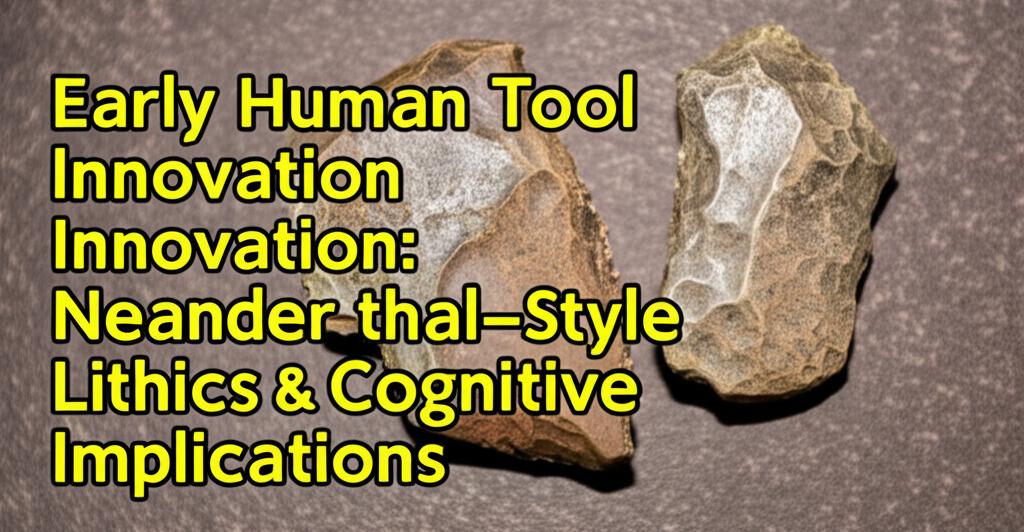Recent discoveries are reshaping our understanding of Neanderthals, suggesting they possessed greater cognitive abilities and technological ingenuity than previously acknowledged. This evolving perspective stems from in-depth analyses of their stone tools, particularly those from the Middle Paleolithic period (roughly 40,000 to 400,000 years ago).
Sophisticated Adhesive Technology:A key finding, published in early 2024, revolves around the use of complex adhesives by Neanderthals. Researchers examining stone tools from the Le Moustier site in France, dating back 40,000 to 120,000 years, found evidence of a multi-component adhesive made from ochre and bitumen. This discovery is significant as it represents the earliest known use of such a complex adhesive in Europe.
The mixture, containing more than 50% ochre, created a malleable substance that was sticky enough to secure stone tools to handles or to be molded into grips directly. This demonstrates a sophisticated understanding of material properties. The high ochre content made the adhesive less sticky to the skin, allowing for easier handling during tool production. Microscopic wear patterns on these tools confirm they were used with these grips.
The production of this adhesive implies advanced cognitive processes, including:
- Forward Planning: Neanderthals needed to gather specific raw materials, sometimes from distant locations.
- Complex Problem Solving: They experimented with and understood the properties of different materials to create an effective adhesive with desired characteristics.
- Abstract Thought: The ability to conceptualize a multi-step process and the final product.
This adhesive technology is comparable to that used by early Homo sapiens in Africa, suggesting similar thought patterns and cognitive capabilities between the two groups.
Mastery of Stone Tool Production (Lithics):Further research into Neanderthal toolmaking, specifically the Levallois technique, reveals a high degree of skill and cognitive demand. The Levallois technique, used between 200,000 and 400,000 years ago, involves preparing a stone core to produce flakes of a predetermined size and shape.
A 2025 study challenged previous assumptions that flake morphology was primarily determined by the core's geometry. Through controlled experiments, researchers found that Neanderthals had precise control over the angle at which they struck the stone cores (angle of blow). This ability to modify strike angles in the moment indicates:
- Advanced Motor Coordination: Precise and controlled movements were necessary.
- Dynamic Decision-Making: Neanderthals weren't just following a preset pattern but adapting their technique based on the specific core and desired outcome.
- Enhanced Working Memory: The ability to hold multiple factors in mind simultaneously.
This level of control and adaptability in tool production points to complex cognitive functions, including foresight and long-term memory. Some researchers even link these abilities to the potential for linguistic capabilities.
Expanding the Toolkit: Beyond Stone:While "lithics" refers to stone tools, it's important to note that Neanderthal technology wasn't limited to stone. Evidence suggests they also utilized bone and wood. The discovery of wooden digging sticks and spears, requiring complex shaping and understanding of material mechanics, further supports their advanced cognitive faculties. Recent analytical methods have also uncovered a richer bone tool industry than previously recognized, challenging the notion that this was a significant cognitive gap between Neanderthals and Homo sapiens.
Cognitive Implications:These findings collectively paint a picture of Neanderthals as highly intelligent and adaptable hominins. Their tool innovations demonstrate:
- Complex Cognition: The ability to plan, problem-solve, and think abstractly.
- Cultural Transmission: The skills and knowledge for these complex technologies were likely shared and passed down within Neanderthal groups.
- Behavioral Flexibility: They could adapt their techniques and create new solutions to meet their needs.
The growing body of evidence challenges the outdated stereotype of Neanderthals as primitive or simple-minded. Instead, it suggests a species with cognitive abilities much closer to our own, capable of significant technological innovation and complex behaviors. The study of their lithic technology, and tool use more broadly, continues to provide crucial insights into the evolution of the human mind.

